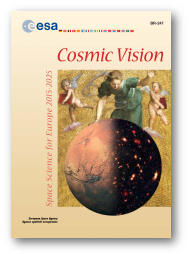ESA Science & Technology - Publication Archive
Publication archive
Publication archive
Reference: ESA/SCI(2021)2
This is the Assessment Study Report (also known as the Yellow Book) for THESEUS (Transient High-Energy Sky and Early Universe Surveyor) - a candidate mission for the M5 launch opportunity in Cosmic Vision.
THESEUS is designed to fully exploit the unique and breakthrough potentialities of Gamma-Ray Bursts for investigating the Early Universe and advancing multi-messenger astrophysics, while simultaneously vastly increasing the discovery space of high energy transient phenomena over the entirety of cosmic history.
Reference: ESA/SCI(2021)1
This is the Assessment Study Report (also known as the Yellow Book) for EnVision - a candidate mission for the M5 launch opportunity in Cosmic Vision.
EnVision is a Venus orbiter mission that will determine the nature and current state of Venus' geological evolution and its relationship with the atmosphere, to understand how and why Venus and Earth evolved so differently.
Reference: ESA/SCI(2017)4
This is the Assessment Study Report (Yellow Book) for XIPE (X-ray Imaging Polarimetry Explorer). XIPE is a candidate mission for the M4 medium-class mission in ESA's Science Programme.
Reference: ESA/SCI(2017)3
This is the Assessment Study Report (Yellow Book) for THOR (Turbulence Heating ObserveR). THOR is a candidate mission for the M4 medium-class mission in ESA's Science Programme.
Reference: ESA/SCI(2017)2
This is the Assessment Study Report (Yellow Book) for ARIEL (Atmospheric Remote-sensing Infrared Exoplanet Large-survey). ARIEL is a candidate mission for the M4 medium-class mission in ESA's Science Programme.
In November 2013, ESA's Science Programme Committee decided that the L3 mission will address the theme 'The Gravitational Universe', responding to the science goals set out in the 2013 report of the Senior Science Committee. Accordingly, a Gravitational Wave Observatory is definitively in ESA's long-term planning, with a (programmatic) launch date of 2034.
Such a space mission presents a set of demanding challenges for the measurement accuracies and associated technologies. Accordingly, in late 2014, ESA's Director of Science and Robotic Exploration appointed an external committee, the Gravitational Observatory Advisory Team, to advise on the scientific and technical implementation of L3.
The Terms of Reference of the committee (given in Chapter 1) can be paraphrased as follows: (a) is the mission technically feasible? (b) is laser interferometry still the best approach to the measurement of gravitational waves from space? (c) how can the technical development of L3 be organised to minimize cost and schedule overruns?
The Committee was asked to report in mid-2016, and this document is the outcome of its work.
Reference: ESA/SRE(2013)7
This Definition Study Report (also known as the Red Book) presents the outcome of the CHEOPS Definition study. It describes the resulting mission concept that will fulfil the mission science requirements, and therefore allow us to achieve the science objectives presented in the original proposal, and further detailed and elaborated in this document.
This technical review report for the SPICA candidate mission presents the outcome of ESA's internal review of this M-class candidate mission in the Cosmic Vision 2015-2025 plan. The review was concluded at the end of the mission assessment phase and carried out in frame of the down-selection to 3 or 4 M-class missions, which will proceed to the definition phase. The main goal of this internal review was to identify the mission's critical issues and associated risks at technical, programmatic and financial level.
SPICA is a JAXA led astronomical mission. The ESA contribution to the SPICA mission, mainly entailing the provision of the cryogenic telescope assembly, is a M-class candidate in the Cosmic Vision 2015-2025 Plan. This document provides a summary of the work performed between August 2008 and September 2009 as part of the SPICA assessment phase study.
In the frame of ESA Cosmic Vision assessment study, Thales propose a 3.5m diameter Ritchey-Chretien telescope in HB-Cesic ceramics. The evaluation of its performances demonstrate that the proposed design perfectly fulfils the mission requirements. The objective of this paper is to provide to the reader an overview of the telescope design and performances of the HB-Cesic SPICA Telescope. The development plan is also addressed. It has been established to minimize risks and schedule. The last point is a sensitivity analysis to pupil diameter reduction: an interesting way to further reduce development schedule.
- Cosmic Vision Cycle 1
- Selected Missions
- Assessment Studies
- National Activities Parallel to Cosmic Vision studies
- Technology Developments
- Schedule

Ten to twenty years from now, a succession of clever new spacecraft will need to be ready to fly in ESA's continuing Science Programme, now called Cosmic Vision. They will tackle some of the big scientific questions that are high on the agenda of research across Europe (and, indeed, worldwide) concerning the Universe and our place in it:
- what are the conditions for planet formation and the emergence of life?
- how does the Solar System work?
- what are the fundamental physical laws of the Universe?
- how did the Universe originate and what is it made of?
This brochure gives a detailed overview of the Cosmic Vision 2015-2025 plan. The opportunities under the above four main headings are presented, and specific aspects of each general theme that are judged to be especially ripe for investigation by new space tools in the period 2015-2025 are identified. A review of the technology that will have to be developed is given.
The presented planning on behalf of the scientific community and aerospace industry takes into account the Science Directorate's preliminary reckoning of the practical constraints of technology. In the section 'Proposed Strategies and Their Implementation', the outcome of these deliberations is summarised in four tables that correspond to the above four key questions.
